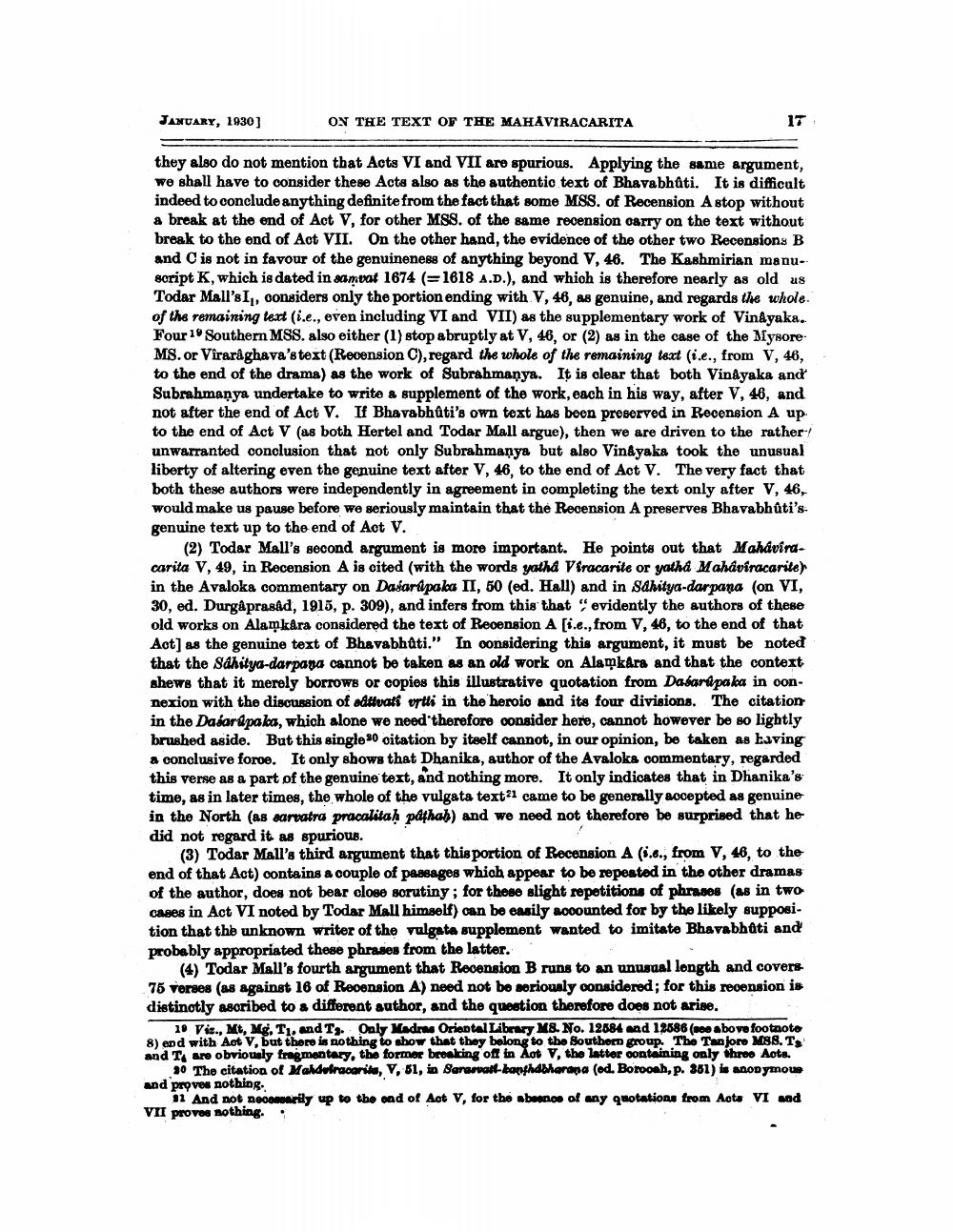________________
JANUARY, 1930]
ON THE TEXT OF THE MAHAVIRACARITA
17
they also do not mention that Acts VI and VII are spurious. Applying the same argument, we shall have to consider these Acts also as the authentic text of Bhavabhati. It is difficult indeed to conclude anything definite from the fact that some MSS. of Recension A stop without a break at the end of Act V, for other MSS. of the same recension oarry on the text without break to the end of Act VII. On the other hand, the evidence of the other two Recensions B and is not in favour of the genuineness of anything beyond V, 46. The Kashmirian manuscript K, which is dated in samvat 1674 (1618 A.D.), and which is therefore nearly as old us Todar Mall's I, considers only the portion ending with V, 46, as genuine, and regards the whole. of the remaining text (i.e., even including VI and VII) as the supplementary work of Vinayaka. Four 1 Southern MSS. also either (1) stop abruptly at V, 46, or (2) as in the case of the Mysore MS. or Viraraghava's text(Recension C), regard the whole of the remaining text (i.e., from V, 46, to the end of the drama) as the work of Subrahmanya. It is clear that both Vinkyaka and Subrahmanya undertake to write a supplement of the work, each in his way, after V, 46, and not after the end of Act V. If Bhavabhati's own text has been preserved in Recension A up to the end of Act V (as both Hertel and Todar Mall argue), then we are driven to the ratherunwarranted conclusion that not only Subrahmanya but also Vinayaka took the unusual liberty of altering even the genuine text after V, 46, to the end of Act V. The very fact that both these authors were independently in agreement in completing the text only after V, 46, would make us pause before we seriously maintain that the Recension A preserves Bhavabhûti's. genuine text up to the end of Act V.
(2) Todar Mall's second argument is more important. He points out that Mahaviracarita V, 49, in Recension A is cited (with the words yatha Vfracarite or yatha Mahaviracarite) in the Avaloka commentary on Dasarti paka II, 50 (ed. Hall) and in Sahitya-darpana (on VI, 30, ed. Durgaprasad, 1915, p. 309), and infers from this that evidently the authors of these old works on Alamkara considered the text of Recension A [i.e., from V, 46, to the end of that Aot] as the genuine text of Bhavabhậti." In oonsidering this argument, it must be noted that the Sahitya-darpana cannot be taken as an old work on Alamkara and that the context shews that it merely borrows or copies this illustrative quotation from Dabartpaka in oonnexion with the discussion of adttuati urtli in the heroio and its four divisions. The citation in the Dasarúpaka, which alone we need therefore consider here, cannot however be so lightly brushed aside. But this singles citation by itself cannot, in our opinion, be taken as having a conclusive foroe. It only shows that Dhanika, author of the Avaloka commentary, regarded this verse as a part of the genuine text, and nothing more. It only indicates that in Dhanika's time, as in later times, the whole of the vulgata texta1 came to be generally accepted as genuine in the North (as sarvatra pracalitaḥ påthah) and we need not therefore be surprised that he did not regard it as spurious.
(3) Todar Mall's third argument that this portion of Recension A (i..., from V, 46, to the end of that Act) contains a couple of passages which appear to be repeated in the other dramas of the author, does not bear close scrutiny; for these slight repetitions of phrases (as in two cases in Act VI noted by Todar Mall himself) can be easily accounted for by the likely supposition that the unknown writer of the vulgata supplomont wanted to imitate Bhavabhati and probably appropriated these phrases from the latter.
(4) Todar Mall's fourth argument that Recension B runs to an unusual longth and covers 75 verses (as against 16 of Recension A) need not be seriously considered; for this recension is distinotly ascribed to a different author, and the question therefore does not arise.
10 Viz., Mt, Mg, T, and Ty. Only Madros Oriental Library M8. No. 12684 and 12688 (100 above footnoto 8) end with Aot V, but there is nothing to show that they belong to the Souther group. The Tanjore M88. TO and Tare obviously fragmentary, the former broalcing on in Ao V, the latter containing only mroo Aote.
30 The citation of Mahdolracorita, V, 61, in Sarapat-kanthabharana (od. Borooah, p. 361) is anonymous and proves nothing.
n And not necesarily up to the end of Act V, for the abuonos of any quotations from Acts VI sad VII proves nothing. .




